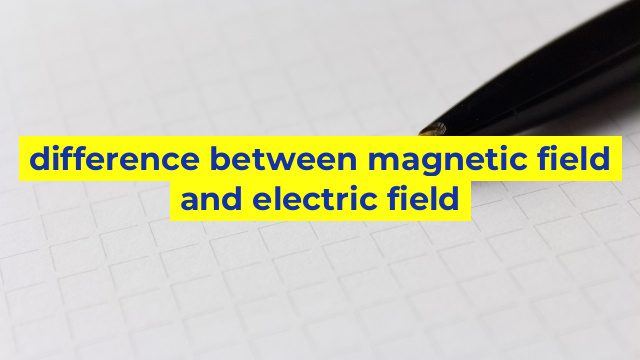The Fundamental Differences between Magnetic Field and Electric Field
Introduction
Both magnetic fields and electric fields are fundamental concepts in physics. However, despite being closely related, there are significant differences between the two fields. Understanding these differences is critical to comprehend the principles of electromagnetism.
Electric Field
An electric field is defined as the invisible force that surrounds electrically charged objects. It is a vector field, which means it has a magnitude and direction at every point in space. An electric field is generated by a charged object and its intensity decreases as the distance from the object increases. The strength of the electric field is measured in units of volts per meter.
An electric field experiences a force when placed in the presence of another electrically charged object. For instance, when a charged particle is placed in an electric field, it experiences a force proportional to the magnitude of the charge.
Magnetic Field
A magnetic field is a vector field that is generated by moving electric charges or magnetic dipoles. Unlike an electric field, a magnetic field does not have a source or sink that generates it. Instead, a magnetic field is produced when charged particles move.
Magnetic fields are measured in units of teslas or gauss. When a charged particle moves through a magnetic field, it experiences a magnetic force perpendicular to its motion and the direction of the magnetic field.
Differences between Magnetic Field and Electric Field
There are several significant differences between magnetic fields and electric fields. Here are some of the most important distinctions:
1. Source: An electric field is generated by a charged object. In contrast, a magnetic field is produced by moving charged particles.
2. Direction: An electric field always points towards or away from a charged object, depending on whether the object is negative or positive. In contrast, a magnetic field is always perpendicular to the direction of motion of the charged particle that generates it.
3. Force: A charged particle experiences a force when placed in an electric field. Meanwhile, a moving charged particle experiences a force when placed in a magnetic field.
4. Distance: The strength of an electric field decreases as the distance from the charged object increases. In contrast, the strength of a magnetic field remains constant at any distance.
Conclusion
To sum up, magnetic fields and electric fields are closely related concepts that play significant roles in electromagnetism. While they share many features, there are fundamental differences between them, including their source, direction, and effects on charged particles. Understanding these differences is essential to grasp electrostatics and the principles of electric current flow.
Table difference between magnetic field and electric field
Magnetic Field vs Electric Field
| Characteristic | Magnetic Field | Electric Field |
|---|---|---|
| Nature | A magnetic field is the area within a magnet or around a moving charged particle where the force of magnetism can be detected. | An electric field is the area around a charged particle where the force of electrostatic attraction or repulsion can be detected. |
| Representation | A magnetic field is represented by magnetic field lines that indicate its direction and strength. | An electric field is represented by electric field lines that indicate its direction and strength. |
| Source | A magnetic field is produced by moving charges and magnets. | An electric field is produced by charged particles. |
| Effect on charges | A magnetic field can exert a force on a moving charge and can channel a flow of charges in a specific direction. | An electric field can accelerate or decelerate charged particles and can also channel a flow of charges in a specific direction. |
| Units of measurement | Magnetic field strength is measured in units of Tesla or Gauss. | Electric field strength is measured in units of Volts per meter (V/m) or Newtons per coulomb (N/C). |
| Applications | Electromagnets, motors, generators, MRI machines, speakers, and compasses are some of the applications that take advantage of magnetic fields. | Electrical power transmission, charged particle acceleration, and electric motors are some of the applications that take advantage of electric fields. |
